
Pasadena is a city in Los Angeles County, California, United States, 11 miles (18 km) northeast of Downtown Los Angeles. It is the most populous city and the primary cultural center of the San Gabriel Valley. With its substantial downtown area, observers consider it as either a suburb of nearby Los Angeles, or as a significant urban center in its own right.

Monrovia is a city located in the foothills of the San Gabriel Mountains in the San Gabriel Valley of Los Angeles County, California, United States. The population was 36,590 at the 2010 census, down from 36,929 in 2000. Monrovia has been used for filming TV shows, movies and commercials.
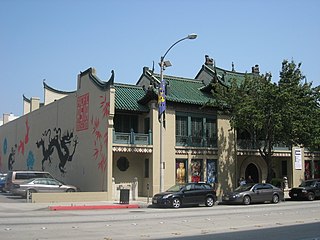
USC Pacific Asia Museum is an Asian art museum located at 46 N. Los Robles Avenue, Pasadena, California, United States.

This is a list of the National Register of Historic Places listings in Los Angeles County, California.

Pasadena City Hall, completed in 1927, serves as the central location for city government in the City of Pasadena, California and it is a significant architectural example of the City Beautiful movement of the 1920s.

The Robert A. Millikan House is a historic house at 5605 South Woodlawn Avenue in the Hyde Park community area of Chicago, Illinois, Built about 1907, it was from about 1908 until 1921 the home of American physicist Robert A. Millikan (1868-1953), the period in which he made his most significant Nobel Prize winning work. The three-story brick building earned National Historic Landmark status on May 11, 1976.
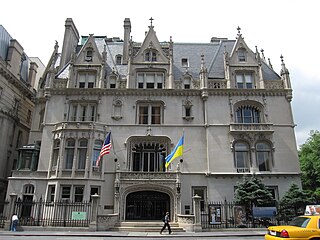
The Harry F. Sinclair House, also called the Isaac D. Fletcher House, is a mansion at the southeastern corner of East 79th Street and Fifth Avenue, Manhattan, New York City. The Sinclair House was built in the last three years of the 19th century. Over the first half of the 20th century, the house was successively the residence of magnates Isaac D. Fletcher and Harry F. Sinclair, and then the descendants of Peter Stuyvesant, the last Director of New Netherland. In 1955, it became the home of the Ukrainian American Institute, which began restoring the Sinclair House. The house was added to the National Register of Historic Places and was named a National Historic Landmark in 1978.
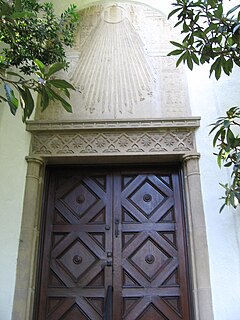
The Hale Solar Laboratory is a historic astronomical observatory in Pasadena, Los Angeles County, California. Built in 1923, it was the laboratory of astronomer George Ellery Hale (1868-1938), a pioneering figure in the development of the discipline of astrophysics in the United States. The building, a distinctive blend of Mission Revival and Spanish Colonial Revival styles, was designated a National Historic Landmark in 1989.

Village Green, originally named Baldwin Hills Village, is a neighborhood at the foot of Baldwin Hills, within the city of Los Angeles, California. Village Green consists of a large condominium complex that is both a Los Angeles Historic-Cultural Monument and a National Historic Landmark. Designed in the late 1930s and built out by 1942, it is one of the oldest planned communities of its type in the nation.

The Albert Kahn House is in Midtown Detroit, Michigan, within the Brush Park district. It is currently the headquarters of the Detroit Urban League. The house was designated a Michigan State Historic Site in 1971 and listed on the National Register of Historic Places in 1972.

South Park Lofts, located in downtown Los Angeles, was built in 1924 as an eight-story parking garage. It was one of America's first parking structures, and is one of the few parking garages listed in the National Register of Historic Places, having received the distinction in 2004. The building has been converted to lofts and is now known as "South Park Lofts." As "Building at 816 Grand Avenue", it is one of more than ten buildings designed by Claud Beelman listed on the National Register.

Bungalow Heaven is a neighborhood in Pasadena, California named for the more than 800 small craftsman homes built there from 1900 to 1930, most of which still stand. Much of the area became a landmark district in 1989 and annual historic home tours have been conducted in Bungalow Heaven every year since then.

Millard House, also known as La Miniatura, is a textile block house designed by Frank Lloyd Wright and built in 1923 in Pasadena, California. It was listed on the National Register of Historic Places in 1976.

This is a list of the National Register of Historic Places listings in Pasadena, California.
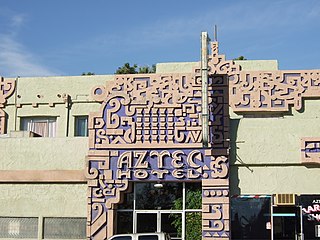
The Aztec Hotel is a historical landmark building in Monrovia, in the San Gabriel Valley, California. The hotel is an example of Mayan Revival architecture still in existence. It was designed by architect Robert Stacy-Judd, and built on U.S. Route 66 in 1925-26. The hotel was closed for renovations in 2012. As of October 2014, the renovations were on-going.
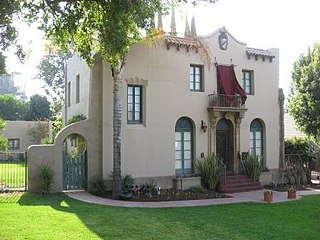
Norton & Wallis was an architectural firm in Los Angeles that designed several historic buildings. The firm included partners, Samuel Tilden Norton (1877–1959) and Frederick H. Wallis. Wallis is credited as the designer of the Upton Sinclair House, a National Historic Landmark in Monrovia, California.
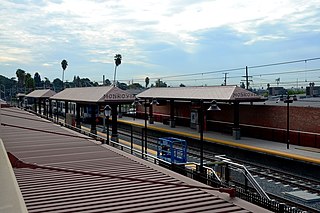
Monrovia is an at grade light rail station in the Los Angeles County Metro Rail system located near the intersection of Duarte Road and Myrtle Avenue in Monrovia, California. This station is served by the Metro L Line.

The Russian Village District comprises 15 folk architecture style houses and was built by Konstanty ("Steve") Stys, a Polish immigrant, and others during the Great Depression. It is located at the intersection of South Mills Avenue and East Cucamonga Avenue in Claremont, California. Although the street addresses are in Claremont, portions of many of the parcels in the district lie within the city of Montclair in San Bernardino County. The historic district was listed in the National Register of Historic Places in 1978.
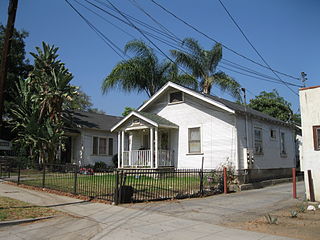
The Court at 1274–1282 North Raymond Avenue is a bungalow court located at 1274–1282 North Raymond Avenue in Pasadena, California. The court consists of five one-story bungalows arranged around a central courtyard. The houses are designed in a blend of the Colonial Revival and American Craftsman styles; the former can be seen in the entrance porticos on three of the buildings, while the latter is present in the homes' overhanging eaves and exposed rafter tails. Owner Karl Valentine designed and built the court in 1924–25.

The Court at 638-650 North Mar Vista Avenue is a bungalow court located at 638-650 North Mar Vista Avenue in Pasadena, California. Owner Karl Valentine built the court in 1927. The court consists of four single-family houses arranged alongside a courtyard with a duplex at the rear of the property. The buildings are designed in the Colonial Revival style and feature classical entrance porticos and wide eaves with exposed rafter tails.


























